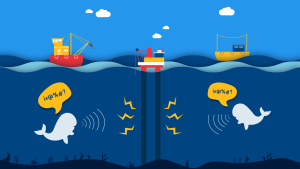
Los animales marinos no sólo utilizan el sonido para comunicarse, mucho de ellos, lo usan para orientarse. La luz sólo penetra a unos pocos metros de la superficie; sin embargo, el sonido viaja a unos 1500m/s, por lo que se desplaza rápidamente.
La bioacústica estudia los procesos fisiológicos que permiten la percepción y producción de sonidos. Los cétaceos y los peces pueden producir y percibir sonidos a través de sistemas auditivos complejos, lo que les permite comunicarse mediante señales acústicas. Asimismo, los invertebrados, pese a carecer de oído parecido al de los vertebrados, contienen órganos sensoriales especializados en recibir las vibraciones sonoras.
En los últimos 100 años, el ser humano ha introducido en el océano una gran cantidad de fuentes de contaminación acústica, generada por barcos, prospecciones, explotaciones de petróleo y gas, construcción, operación de parques eólicos, puertos y puentes, sonar milita ro comercial). Estos ruidos han invadido el espacio marino y ha afectado de manera crítica a las especies. Muchas especies no tienen la capacidad para huir a parajes más silenciosos y están condenados a sufrir las consecuencias de la exposición al ruido, tanto a nivel morfológico, como fisiológico y comportamental.
Algunas de las acciones que pueden verse modificadas en su comportamiento son, por ejemplo, la falta de capacidad para cerrar las valvas o recuperar la posición natural; también afecta a la hora de excretar tinta, tener una reacción de alarma, incrementar su agresividad o limitar la defensa frente a un depredador. Asimismo, pueden sufrir cambios en su alimentación, crecimiento, respiración o reproducción, así como en el desarrollo de los huevos y las larvas.
En cuanto a los sonidos de alta intensidad durante un tiempo prolongado, las consecuencias pueden ser mucho peores: se pueden dar roturas masivas de órganos internos (barotrauma), cambios en los niveles de percepción de sonido y en las estructuras encargadas de percibirlo (lesiones en las células sensoriales), e incluso puede acabar provocando la muerte de muchas especies. Por otro lado, a todos estos fenómenos, se le debe sumar el nivel de estrés, que altera tanto las hormonas, como el metabolismo, disminuyendo la capacidad de respuesta inmune y condicionando la fisiología cardíaca, provocando daños irreversibles en el ADN.
El ruido que introduce el ser humano en los océanos representa una creciente presión al que se está sometiendo el medio marino. Como parte activa y responsable de la generación de este peligro, debemos comprometernos a garantizar y salvaguardar la supervivencia de ecosistemas vitales que habitan el medio marino y devolverles el silencio al que estaban acostumbrados.
¿Te ha interesado el tema?
Lee más AQUÍ
__
MARINE NOISE AND NOISE POLLUTION
Marine animals not only use sound for communication, many of them use it for orientation. Light only penetrates to within a few meters of the surface; however, sound travels at about 1500m/s, so it travels quickly.
Bioacoustics studies the physiological processes that enable the perception and production of sound. Cetaceans and fish can produce and perceive sounds through complex auditory systems, allowing them to communicate by means of acoustic signals. Likewise, invertebrates, despite lacking vertebrate-like hearing, contain sensory organs specialized in receiving sound vibrations.
Over the past 100 years, humans have introduced a large number of sources of noise pollution into the ocean, generated by ships, drilling, oil and gas exploration, construction, wind farm operations, ports and bridges, and commercial military sonar.) These noises have invaded the marine space and have critically affected species. Many species do not have the capacity to escape to quieter places and are condemned to suffer the consequences of noise exposure, both morphologically, physiologically and behaviorally.
Some of the actions that can be modified in their behavior are, for example, the lack of ability to close the valves or recover the natural position; it also affects the time to excrete ink, have an alarm reaction, increase their aggressiveness or limit the defense against a predator. They may also suffer changes in their feeding, growth, respiration or reproduction, as well as in the development of eggs and larvae.
As for high intensity sounds over a prolonged period of time, the consequences can be much worse: there can be massive ruptures of internal organs (barotrauma), changes in the levels of sound perception and in the structures responsible for perceiving it (lesions in the sensory cells), and can even end up causing the death of many species. On the other hand, to all these phenomena must be added the level of stress, which alters both hormones and metabolism, decreasing the immune response capacity and conditioning cardiac physiology, causing irreversible damage to DNA.
The noise introduced by humans into the oceans represents an increasing pressure to which the marine environment is being subjected. As an active and responsible party in the generation of this danger, we must commit ourselves to guarantee and safeguard the survival of vital ecosystems that inhabit the marine environment and return them to the silence to which they were accustomed.
__

